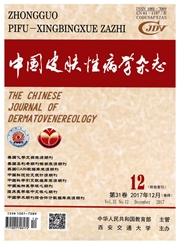

 中文摘要:
中文摘要:
目的通过检测慢性难愈性皮肤溃疡创面Wnt信号通路关键蛋白β-catenin,c-myc与K6蛋白的表达,探讨该通路与皮肤溃疡难愈性的关系。方法以正常组织为对照,采用免疫组化及图像定量分析相结合的方法,检测β-catenin,c-myc与K6蛋白在慢性难愈性创面组织中的表达。结果慢性难愈性创面处β-catenin,c-myc与K6蛋白在表皮中的表达均明显增强,β-catenin在创缘呈现异常核表达;K6,c-myc全层表达,且在颗粒层表达增强,与正常组织相比差异具有统计学意义(P〈0.01)。结论慢性难愈性溃疡创面Wnt信号通路相关蛋白β-catenin,c-myc与K6表达增强,提示Wnt信号通路异常可能与创面迁延不愈密切相关。
 英文摘要:
英文摘要:
Objective To investigate the expression of β-catenin,c-myc and K6 in non-healing skin ulcer,and explore the relationship between the canonical Wnt signaling pathway and non-healing skin ulcer. Methods Normal skin tissues were used as control group,and the expression of β-catenin,c-myc and K6 in non-healing skin ulcers were determined by immunohistochemical SABC method and quantitative image analysis. Results In non-healing skin ulcer,the rate of abnormal expression of β-catenin,c-myc and K6 was much higher than that in normal skin(P0.01).Nuclei β-catenin could be found at the edge of wounds. Expression of c-myc and K6 could be found at full-thickness skin,especially at granulosum layer. Conclusion In the progress of non-healing skin ulcer,the abnormal expression of β-catenin,c-myc and K6 may play a pivotal role in the progression of non-healing skin ulcer,which indicates that the canonical Wnt signaling has important effects on pathogenesis and development of Non-healing skin ulcer.
 同期刊论文项目
同期刊论文项目
 同项目期刊论文
同项目期刊论文
 Effects of External Application of Chinese Medicine on Diabetic Ulcers and the Expressions of beta-c
Effects of External Application of Chinese Medicine on Diabetic Ulcers and the Expressions of beta-c 期刊信息
期刊信息
